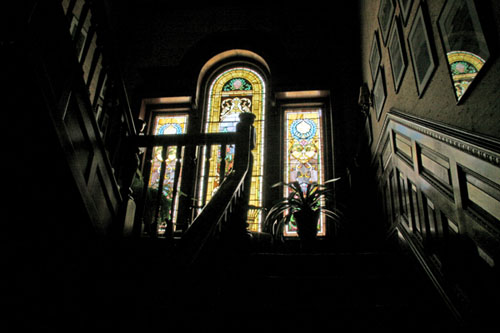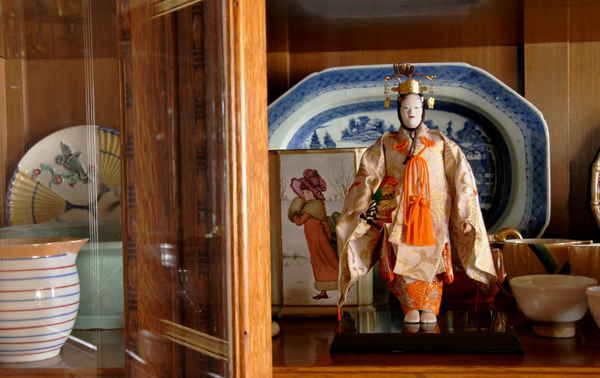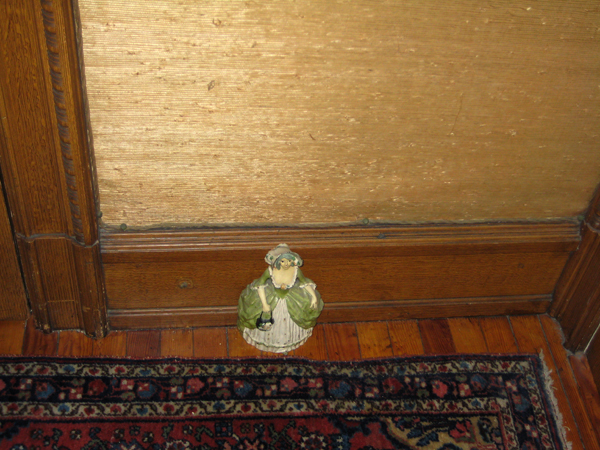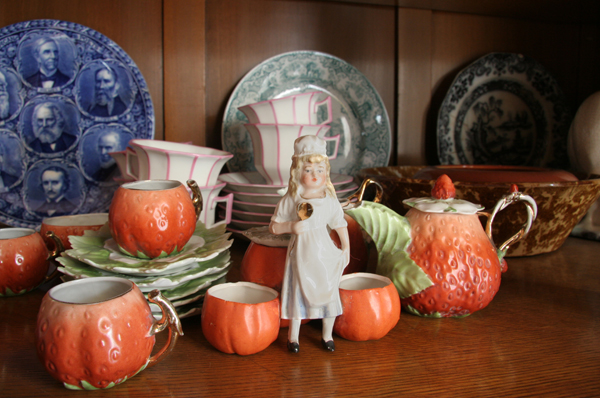The Little House of Our Desire1
by Micaela Morrissette
Illustrated by Ahndraya Parlato
From nests as admirable as these, wallpaper islands,
the vivid flow reverses. That’s in-house.
—“From Such Commotion,” WakefulnessThe eyes in the head in the house
—“The Shocker,” Can You Hear BirdSuddenly, shambling / she comes up to me, a thing partly of architecture
—“William Byrd,” And the Stars Were ShiningThe name of the castle is you, El Rey. . . . I am the inhabitable one.
—“Valentine,” Houseboat Days
The interior of John Ashbery’s Hudson home crashes in silent and shocking crescendo around the suddenly small form of the guest who steps in the front door. The first impression is of momentous, bullying grandeur. The front hall is fierce and terrible in an armor of woodwork. To the left is the music room: white marble; sharp faceted glass; pink fabrics, satiny or plush; like the kind of woman you’ll never get to touch. To the right is the library, the backs of the chairs in painfully perfect postures, severe and rather cruel. You can glimpse ahead the dining room with its ponderous, monumental table, its glass-fronted cabinets dangerous with arrears of fragile china. The light is very dim. The windows are thickly curtained, closing out the outside world altogether, or gauzily draped, blurring the exterior scene and filtering the illumination into a milky haze. On the other hand, the artwork tears open strange vortexes in the walls, windows to other worlds, like Narnian pools. An iceberg rears above the fragile loveseat; in the shadows are the pale, paralyzed bodies of monkeys. The front staircase swells above you, inducing vertigo; the sun that struggles through the stained-glass on the landing falls heavy and slow on your head, choked with dark shades of ruby and azure. Immense Persian carpets swallow the floors; your feet fumble in their designs as through a treacherous undergrowth of roots and tangling vines. The hush is suffocating; you can feel it pressed against your face. The house might be haunted, if it were not for the utter, pristine stillness of the scene. You are convinced that not even ghosts rest in these fragile seats or pass through the doorways, the frames of which are swollen with the scene that lies on the other side, pressing to intrude.

Photo by Ahndraya Parlato
If you navigate the stairs to the second floor, you gain what seems at first a reprieve. The battering, monstrous scale of the formal rooms below gives way to a sly playfulness. Elderly toys and mocking cartoon figures disport in the sudden sunlight. You arrive in a space that is completely inhabited, immensely personal. The pictures on the wall no longer open into alien landscapes, but shimmer like memories or daydreams fluttering against the surface of consciousness—a summer cottage, a city street bleached with white light, a landscape seen through half-sleep and eyelashes, the owner’s own face, turning away from his gaze. The atmosphere is still sumptuous—outrageously opulent wallpapers make each space a cunningly wrought bauble in which the guest is passively imprisoned—but the immensity no longer sounds its gonging note. The new panic is one not of scale but of detail. You reel before your apprehension of the infinitude of objects, both upstairs and down. The objects themselves are lavishly patterned. Objects are arranged in small scenes and confrontations. Objects self-replicate in kaleidoscopic collections. Objects miniscule and isolate are everywhere, everywhere—behind the doors, pressed against the corners of the wall, are mincing, blushing men and women; in the dining room, half-obscured by a rhapsody of crystal, a tiny pair of haughty golden birds writhe their long necks; on the round table by the window, a black metal rose is camouflaged by the intricate carving of the ebony tabletop. The profusion is staggering, magnificent, overpowering. Ecstasy and despair rush in, twittering madly.
When the sun sets, the house is different, warmer, closer. Lamplight droops and puddles over the carpets and upholsteries, the carvings hum quietly, and the shadowed alcoves, the many corners and turnings, the snaking reflections that weave separate rooms together, soften and melt. As you cease to squint and stare, allowing the objects, the patterns, the textures, the arrangements, the correspondences and disjunctions, to slip, languorous and veiled, into the corners of your eyes, a harmony comes floating out of the deeps, dense and sonorous. The house becomes a reverse space shuttle or time machine. The world outside the curtains roosts in grim silence, immobile and rigid, but, inside the house, nations, epochs, fantasies, twice-told tales, and half-remembrances ripple from room to room, like the gleams and folds of a long train of silk dragging over the floors.
If you stay the night, when you wake, all is changed again. Either the house has awakened into reality, or you have become an unreal thing yourself. Morning light comes spinning and shaking in like snowflakes in the wind. The figurines that prowled the shelves are jolly and cavorting. The bookshelves are all at your disposal, the yellow kitchen is delirious with the smell of buttered toast, and the furnace pants and thumps with the unmistakable struggling vigor of the heart of a living thing.
Ashbery’s apartment in Chelsea is something altogether different. After Hudson, it’s a sharp slap of wind forcing itself into your lungs, the sudden cold breath of morning on eyes snapping open to the alarm. An eyrie, flooded with the exterior world, lolling in the sun or reeling in the rain, dizzily revolving in the sky, white and open and lazily sprawling, it’s a place that receives, a naked and defenseless spot, a complete receptor.

Photo by Ahndraya Parlato
This portfolio of works addresses the Created Spaces2 concept to the domestic worlds Ashbery inhabits. As developed by The Flow Chart Foundation, Created Spaces is a mode of examining the deliberately shaped environments of artists and writers. It requires that the physical spaces an artist has chosen and molded in the course of quotidian existence be rendered the same quality or intensity of appreciation and attention as the artist’s poems, fictions, musical compositions, visual artworks, or so on. It also suggests that comparisons between the artist’s two (or more) created environments may lead to fruitful critical conclusions.
Ashbery is an ideal candidate for such a dissection. His domestic environments are the result of a protracted, minutely considered, wildly imaginative process of previsioning, selecting, populating, arranging, and glossing. The applicability of Created Spaces to his Chelsea apartment is the subject of interesting debate; on the other hand, his Hudson house is overwhelmingly theatrical, esoteric, sumptuous, even alarming, and the aesthetic that has governed its evolution is strikingly similar to that which has informed his poetry. Ashbery’s audience is accustomed to seeing him trip merrily between disciplines—as an actor, playwright, art critic, translator, painter and collagist, and a collaborator in every vein; as a famous enthusiast and as a still more famous source of inspiration to other artists; as a poet who not only references every possible branch of the arts overtly in his work but who also adapts the techniques of musical composition, of abstract expressionism, and of cinema in the structure of the poems themselves—and we are primed to accept that the democracy and universality of his interests and talents may extend to the domestic arts.
That said, this portfolio does not consider Ashbery as Interior Designer. Rather, we see the spaces he has designed as massive installation artworks—outsized dollhouses, stage sets, self-curated home museums, materialized dreams, memories, and desires—four-dimensional poems. Probably the most striking similarity between the textual and domestic environments he creates is the medley of pop culture, Americana, highbrow art, and classical tropes that defines both spaces. The organizing logic of his homes is reminiscent of Giorgio de Chirico’s novel Hebdomeros, in which scenes shift in vast transitions that are at once disjunctive and flowing. (The same point has been made, unceasingly, with regard to Ashbery’s work, though his leaps and bounds tend to exist on the level of syntax and vocabulary, rather than plot or extended description.)

Second-floor hall. Photo by Ahndraya Parlato.
The collaging and collecting impulse central to his writing is echoed in his lived environment. The brooding red of an artwork by R.B. Kitaj, itself a collage, is moderately placated by the cheerful yellow of a Donald Duck wastepaper basket a few feet away in the upstairs hall. An old marble bust of a young French girl gazes pensively and with slight disapproval at the teasing pinks and greens flaunted in a canvas by Trevor Winkfield, whose iconographic paintings mimic collage, or rather, unify collages into a seamlessly painted and inseparable whole. In a visual collage by Ashbery that sits atop a bookcase, a parrot fluffs its exotic feathers under a lightning sky. From directly in front of it, one can just see the parrot’s mate, in the form of a doorknocker bidding entrance to another room. The two birds can mark the boundaries of one visual composition, a three-dimensional collage within which a whole aviary can be discovered: a bluebird in a Japanese print, a quacking Disney figurine, and, reflected in the glass that protects Anne Dunn’s pastoral abstraction in watercolors, the live bodies of sparrows in the tree outside the window.
There are even direct points of intersection between text and domicile. In “Valentine,”3 the following lines appear: “Only the shelf of the mantelpiece shows. At each end, seated on pedestals turned slightly away from one another, two aristocratic bisque figures, a boy in delicate cerise and a girl in cornflower blue. Their shadows join us in a grotesque silhouette. In the center, an ancient clock whose tick acts as the metronome for the sound of their high voices.” An identical scene is constructed on the mantelpiece in the front hall of the Hudson house. The boy and girl are candelabra inherited from Ashbery’s grandparents; Ashbery acquired the timepiece because it reminded him of a clock from his childhood. A CD recording of Claudio Monteverdi’s L’Orfeo is in the rack of the upstairs study; the same music is present throughout Ashbery’s poem “Syringa.” A large poster of a dog purporting to be Rin-Tin-Tin is mounted in the back stairway, but a closer examination reveals the imposter: it is Rin-Tin-Tin, Jr. The ghost of the original Rin-Tin-Tin haunts Ashbery’s play The Compromise, conspicuous in its absence there as well. From the window of Ashbery’s New York apartment, the fluid structure of the driving range at Chelsea Piers is seen, pliable in the river breezes. The same building shifts and changes in the brief space between the title and the first line of Ashbery’s poem “Outside my Window the Japanese. . . .” These literal correspondences are conceptually limited, unable to extend very far beyond anecdote, but they serve as a point of entry into serious consideration of Ashbery’s environments as counterparts to his writing and as artworks sufficient unto themselves.
Ashbery’s domestic spaces do more than supplement or extend his poetic spaces, however; they are incubators for the work, environments designed to foster his writing. Many have commented on the receptivity of his poems to the environments that surround him as he composes. He allows the interruptions and conditions of his everyday life to dictate the lines he transcribes. The sound of music playing, a snatch of color caught at the perimeter of his vision, the feel of his writing-paper snatched up in a draft—all these may find their way into or somehow alter a poem. Yet the “accidental” quality of this relationship between the poems and the space of their creation is perhaps overstated in light of Ashbery’s conscious population and arrangement of the space in which he writes. He has placed the needle on the record, hung the photograph on the wall, and moved his desk in front of the window to catch the breeze.

Photo by Ahndraya Parlato
In Robert Kelly’s contribution to this collection, he speaks explicitly to the emergence of a poem from the particular physical space where it is generated. Archie Rand, too, refers to the Hudson house as the place from which the voice of Ashbery’s poetry speaks. Rand, like contributors Robin Holloway and Joshua Pelletier, has drawn creative inspiration for his own work from Ashbery’s domestic space. (Holloway has written on the process of setting Ashbery’s architecture to music; Pelletier created a series of dark and mythological drawings, based partially on snapshots by photographer David Bush, that imagine the spaces from which Ashbery’s poems originate, or in which those poems take place.)
Roger Gilbert and Brice Brown discuss, in very different ways, the animating urges common to Ashbery’s poetry and to the Hudson and Chelsea spaces, respectively. Karin Roffman uses Ashbery’s domestic creation as a body of evidence in her analysis of the relationship between Ashbery and Marianne Moore’s differing relationships to thingness. David Kermani iterates the role of memory and the simultaneity of time in Ashberian spaces, and applies those ideas to the filmic syntax at work in both the poetry and the lived environments.
In addition to Rosanne Wasserman’s invaluable documentation of Ashbery’s collections and his arrangements of them, she has managed to transform the rooms into metaphors of her own making, without distortion. Rosangela Briscese’s introduction to the preliminary inventory of Ashbery’s libraries brings the Created Spaces approach into focus from an archival, curatorial perspective and points readers to an intriguing array of preserved libraries and historic houses. Michael Gizzi, with Penelope Creeley, offers another sort of context. He understands the Hudson house in the setting of its environs, and speaks to the attention Ashbery brings to his garden and yard and to the effect that the approach and departure to the house have on the experience within.
Gizzi and Creeley have illustrated their contribution with Polaroid photographs, and Rand and Pelletier’s pieces include their own artwork. Otherwise, the texts in this portfolio appear with photographs by Ahndraya Parlato4, who also offers her own portfolio of images, in which the Chelsea and Hudson spaces become Edenic, lush, and lithesome gardens.
I am immensely grateful to Parlato for her indefatigable work fulfilling the illustrative requests of the contributors, and I hope the resultant visualization of the sites will be transformative for readers. One indisputable criticism of a project like this is its insularity, for of course Ashbery’s homes are not open to the public. There are ways to approach his work within a Created Spaces perspective without visiting him personally—for instance, by examining photographs, by analyzing the evocation of domesticity within his poetry, or by joining forces with the ecopoets and looking at his creation of textual habitats or biosystems. Still, the handicap is considerable. Fortunately, any number of other artists working in a wide range of forms are equally eligible for this mode of attention. Serious scholars and artists who have formally undertaken projects relevant to Created Spaces may wish to contact the Flow Chart Foundation at arc at flowchartfoundation dot org to share the results of their investigations.
This portfolio could never have come to pass without the momentous magnanimity of Flow Chart, with David Kermani at the helm (to say nothing of Flow Chart’s conceptual authorship of the project’s entire underlying thesis). I am grateful to FCF, to Rain Taxi, and to all the contributors, who approached this unfamiliar slant of thought keenly and boldly. Briscese (managing director of the Ashbery Resource Center) and Jonathan Boyd (Ashbery’s New York City assistant) provided invaluable aid throughout the process. Most of all I wish to thank John Ashbery for his really shocking generosity in allowing the project to take place at all. The Hudson and Chelsea spaces were created as private pleasures, self-fulfillments, and were never intended to be on display in this way. At home, as in his work, he is a munificent host.
1“Wakefulness,” Wakefulness (New York: Farrar, Straus and Giroux, 1998), pp. 3-4.
2The various implications of a Created Spaces perspective on artists’ habitats has long been of interest to The Flow Chart Foundation (FCF), which sponsored this portfolio.. Flow Chart’s chairman is John Ashbery. I am one of its trustees, as is Archie Rand, who first introduced FCF president David Kermani to the possibilities inherent in a Created Spaces approach to Ashbery’s domestic environments. FCF is an organization that emphasizes contextualized and multimedia approaches to any and every discipline and that is the caretaker of Ashbery’s archive of published materials in Hudson, New York. The Ashbery Resource Center, a Flow Chart subsidiary, maintains the archive and documents its holdings on behalf of Bard College in an extensively annotated, fully searchable online catalog, available at www.flowchartfoundation.org/arc.
3Houseboat Days (New York: Viking, 1977), pp. 62-65.
4Parlato’s photographs do not include the Hudson back stairs, which lead from the kitchen to the second floor, and which are hung with a shocking number of artworks, including some of the strangest and most evocative images in the house. However, photographs of those artworks, taken by former ARC managing director Anni Rudegair, as well as additional photographic documentation of the Hudson and Chelsea spaces, will be available at the Created Spaces section of the ARC website in Fall 2008.
